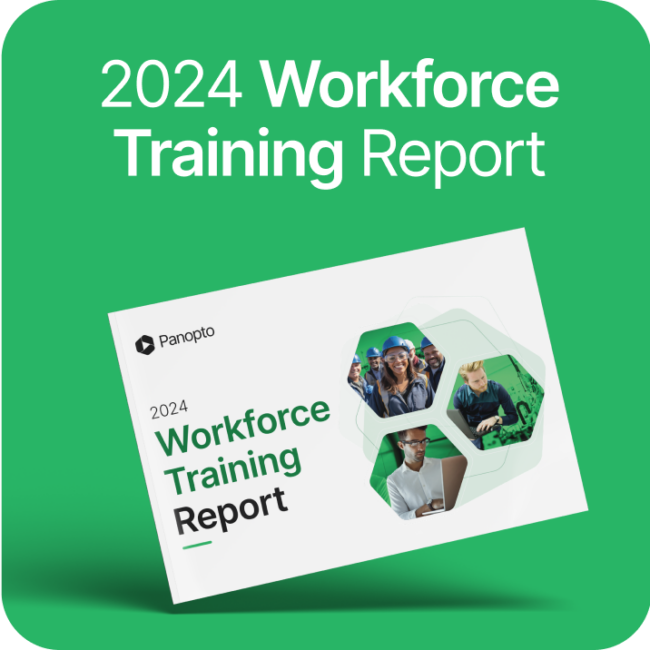- Learning and Development
What is a Learning Experience Platform?

With an increasing number of companies choosing a remote work environment, it’s no longer as easy as going to your colleague in the next office for a hands-on demonstration when you’re stuck. But it’s clear that employees want the remote equivalent. Tellingly, 93% of employees report they want more “easy-to-complete training” – demonstrating the difficulty L&D faces.
L&D teams have the opportunity to take advantage of technology to reach employees, but how do you know what learning technology is the right choice?
In this article, we explore what a Learning Experience Platform (LXP) is, as well as how it compares to a Learning Management System (LMS) or a content or video management system (CMS/VMS) so that you can determine which learning system fits your needs.
What is a Learning Experience Platform?
An LXP is a learning software that lets users create personalized paths based on AI-driven recommendations. What that means is that as a user finishes one piece of content, the LXP recommends similar content to advance the learner to the next step based on their past content engagement or previous engagement from similar users.
But, the user isn’t limited to what the LXP suggests. The learner can change course and shift to another training topic whenever they want. That’s what makes an LXP so powerful – the user remains in control.
An LXP supports user-generated or curated content. This feature allows learners throughout your organization to link to and sometimes create the content they find relevant. In addition, users can easily search, find, and start engaging with the content they want in seconds.
The LXP market continues to grow with popular platforms adding new functionality regularly – continuously adapting to UX advancements. In most cases, an LXP responds faster to shifting demands than traditional learning solutions.
So, now you know what an LXP offers, but how does it compare to other options like an LMS or CMS/VMS?
LXP vs. LMS vs. CMS vs. VMS: What’s the Difference?
While an LXP adds experiential value to your learning stack, it has limitations. For starters, an LXP isn’t the best choice for set learning paths, including tasks such as onboarding. It also doesn’t offer the robust storage and security features of a CMS, nor is it tailor-made for video like a VMS.
This table explains the key differences between an LXP, LMS, CMS, and VMS.
| LXP | LMS | CMS | VMS | |
| What it is | An experiential learning platform where users guide their own paths – primarily powered on AI-driven insights
|
A system for learning management that ensures each user gets the same targeted training
|
A system for creating, storing, and sharing all learning content
|
An asynchronous video technology for creating, hosting, searching, and streaming videos online
|
| Best for… | Self-guided training based on personalized interests – ideal for upskilling
|
Distributing training programs that follow a specific path, such as onboarding and compliance
|
Storing, securing, and sharing all training materials, whether created by the trainer or shared by users
|
Easy capture, management, viewing, and discovery of video content for the purposes of communicating, educating, or entertaining
|
| Downsides | L&D doesn’t control the learning paths – each learner will have a unique experience that may not include everything they need to fully learn a new skill or remain in compliance
|
More difficult for the learner to tailor training to their interests or engage in social learning – designed for L&D to create set training programs
|
Learners that want to go off-path will need to search for content – personalized recommendations aren’t generally built into a CMS
|
Strictly built for video creation and organization – typically does not house numerous types of content
|
| Examples |
|
|
|
|
LMS
Unlike an LXP, an LMS gives control to the trainer. An LMS creates a clear training path that every user follows. It ensures that learners don’t skip or miss any pieces, making it ideal for annual compliance or policy training.
As noted in the table, an LMS guides learners, so user-generated content isn’t at the forefront of the system. On the plus side, this keeps the direction and quality of the content up to the L&D department. However, it also decreases opportunities for social learning.
While both an LXP and LMS offer their own advantages, you cannot ignore what a CMS/VMS brings to your learning stack.
CMS
A CMS is built to create, store, secure, and deliver content. Like an LMS, L&D controls critical training paths to streamline delivery instead of letting users self-guide their learning. However, a CMS generally offers more robust organization and storage than an LXP or LMS. A CMS hosts many types of content.
VMS
A VMS is purpose-built to produce, store, and share video content – a feature many learning stacks are missing. A VMS allows you to create high-quality video training within the system instead of uploading it from an external platform.
Additionally, a VMS improves the user experience of video content by allowing learners to easily search for what they want without sifting through tens to hundreds of videos within a library.
How To Decide if You Need an LXP
Each learning technology offers slightly different functionality, so how do you decide if you need an LXP or another solution?
L&D teams must develop a learning stack that delivers critical training programs but also encourages employees to learn and share knowledge independently. It’s not an easy task given the range of technology available. Most likely, the right solution for your organization is a combination of a few of the different tools. Training technology offers the flexibility you need to pick and choose the tools that make the most sense for your program.
Before deciding if your organization needs an LXP, LMS, CMS, VMS, or a combination, you need to consider:
- How much of your content is self-guided?
As you’ve learned, an LXP isn’t the right choice if you primarily want to direct users down a set path. So, if your organization is heavy on regulatory training, you’ll at least need to consider supplementing an LXP with another option.
Even if your company doesn’t require frequent regulatory training, you want to consider processes like onboarding or upskilling employees before an organizational change, such as replacing outdated technology. Chances are your employees need some training that follows a predetermined sequence and doesn’t deviate based on their interests.
- What type of learning content do your users respond to most?
Video content is more prevalent than ever, with 7 in 10 L&D teams adding video to their learning initiatives. Additionally, research shows that people prefer to engage with video content and are more likely to retain what they learn after watching it – and your employees are no different.
If you’re using video (or considering using it), you need to find out not only if the LXP, LMS, or CMS you’re considering hosts video, but if it helps your team produce, manage, and search video as well. If not, you’ll be left transferring your video from one technology to another – a lengthy process – and need to consider a VMS solution instead.
- What solutions do you already use? What integrations are a must-have?
Employees bounce from one technology to another a shocking 10 times per hour. The last thing your employees need is additional fragmented technology, especially when trying to learn something new.
Think about what technology you currently use for training and internal communications. Does the LXP – or LMS, CMS, or VMS – have an integration for your must-have systems, like video conferencing or a messaging technology like Slack? Or, will your employees have yet another system to juggle?
- Is it secure?
Unsecured internet connections and unnoticed malware are two examples of how your organization’s content can be accessed without permission. Both concerns are more likely with remote teams that may be working in public spaces or on personal devices.
The security of your content cannot be underrated. Much of your content contains proprietary information or internal communications that you don’t want to risk sharing outside of your organization.
- Does it come with advanced analytics and reporting?
The transition from in-person training to virtual training comes with the bonus of advanced analytics and reporting – and you don’t want to miss out on key insights.
Analytics such as what content gets the most engagement and how many times a user views a piece of content helps you understand what your team wants and needs. It can also help you verify who completed onboarding and compliance training without interrupting productivity.
Whether your organization needs an LXP, LMS, CMS, VMS, or the entire stack depends on the type of learning your organization favors. A personalized option like an LXP encourages employees to explore new skills independently. In contrast, an LMS, CMS, or VMS ensures all employees receive the same high-caliber training they need to boost role performance and remain in compliance. Ultimately, it comes down to how your company wants to deliver training now and in the future.
Ready to give video a try?
Learn more about how to improve your training program with Panopto’s VMS platform.




